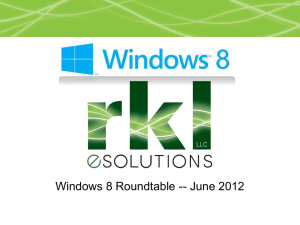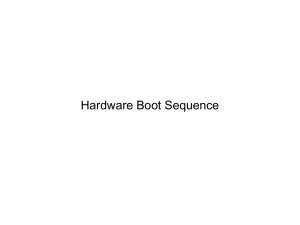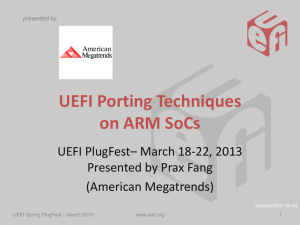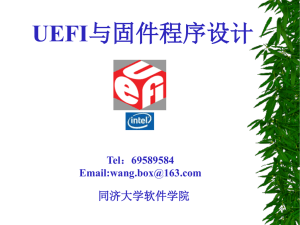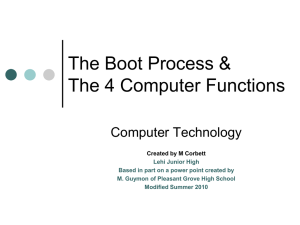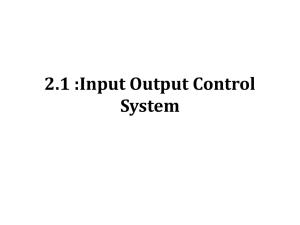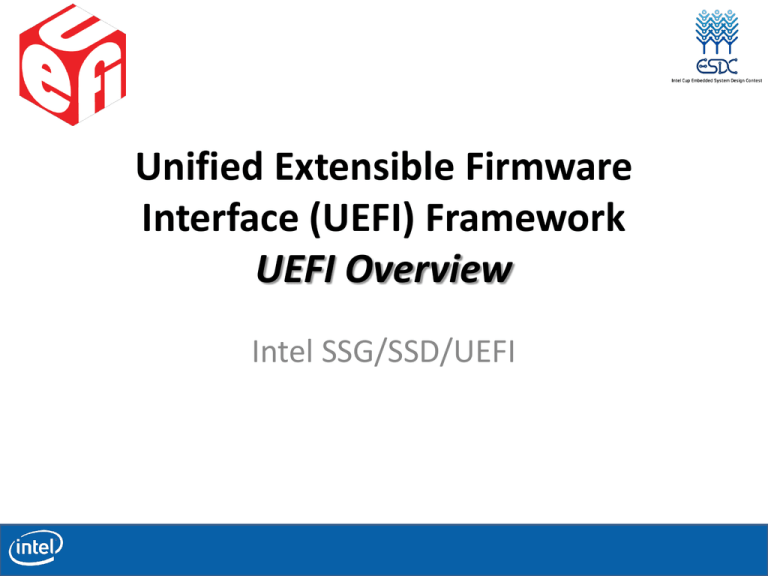
Unified Extensible Firmware
Interface (UEFI) Framework
UEFI Overview
Intel SSG/SSD/UEFI
Legal Disclaimer
INFORMATION IN THIS DOCUMENT IS PROVIDED IN CONNECTION WITH INTEL PRODUCTS. NO LICENSE, EXPRESS OR IMPLIED, BY ESTOPPEL OR OTHERWISE, TO
ANY INTELLECTUAL PROPERTY RIGHTS IS GRANTED BY THIS DOCUMENT. EXCEPT AS PROVIDED IN INTEL'S TERMS AND CONDITIONS OF SALE FOR SUCH
PRODUCTS, INTEL ASSUMES NO LIABILITY WHATSOEVER AND INTEL DISCLAIMS ANY EXPRESS OR IMPLIED WARRANTY, RELATING TO SALE AND/OR USE OF
INTEL PRODUCTS INCLUDING LIABILITY OR WARRANTIES RELATING TO FITNESS FOR A PARTICULAR PURPOSE, MERCHANTABILITY, OR INFRINGEMENT OF ANY
PATENT, COPYRIGHT OR OTHER INTELLECTUAL PROPERTY RIGHT. UNLESS OTHERWISE AGREED IN WRITING BY INTEL, THE INTEL PRODUCTS ARE NOT DESIGNED
NOR INTENDED FOR ANY APPLICATION IN WHICH THE FAILURE OF THE INTEL PRODUCT COULD CREATE A SITUATION WHERE PERSONAL INJURY OR DEATH
MAY OCCUR.
Intel may make changes to specifications and product descriptions at any time, without notice. Designers must not rely on the absence or characteristics of any
features or instructions marked "reserved" or "undefined." Intel reserves these for future definition and shall have no responsibility whatsoever for conflicts or
incompatibilities arising from future changes to them. The information here is subject to change without notice. Do not finalize a design with this information.
The products described in this document may contain design defects or errors known as errata which may cause the product to deviate from published
specifications. Current characterized errata are available on request.
Contact your local Intel sales office or your distributor to obtain the latest specifications and before placing your product order.
Copies of documents which have an order number and are referenced in this document, or other Intel literature, may be obtained by calling 1-800-548-4725,
or go to: http://www.intel.com/design/literature.htm
This document contains information on products in the design phase of development.
All products, computer systems, dates, and figures specified are preliminary based on current expectations, and are subject to change without notice.
Intel, Intel Atom, Intel Core, and the Intel logo are trademarks or registered trademarks of Intel Corporation or its subsidiaries in the United States and other
countries.
* Other names and brands may be claimed as the property of others.
Copyright © 2011, Intel Corporation. All rights reserved.
BLDK PRC Training 2011
Agenda
BIOS Background
UEFI Overview
Platform Initialization (PI)
Overview
BIOS background
What’s Legacy BIOS
•
•
•
•
Basic Input - Output System for original IBM PC/XT and PC/AT
Originated in 1980s
Based on 8086 architecture
A group of clearly defined OS-independent interface for
hardware
Int10 for Video service
Int13 disk service
Int16 keyboard service
Int18 BIOS ROM loader
Int19 bootstrap loader
• Availability of MS-DOS outside of IBM allowed applications to run equally
well across different brands of box "PC clones".
BIOS background
Specifications
EFI / UEFI History Timeline
PCI
Spec
PC Era
1980s
Implementation
1985
IBM 16 Bit
BIOS
framework1
0.9 Spec
Intel®
Itanium®
Platforms
64 bit
develops
1990
EFI
1.02
1995
EFI only
way to boot
Itanium®
Platforms
EFI
1.10
2000
2005
EFI Sample
Implementation
1.10.14.6x
EFI Dev
Kit
(EDK)
Tianocore.org Open
Source
Open Source EFI Developer Kit (EDK) http://www.tianocore.Sourceforge.net
UEFI Specifications - http://www.uefi.org
BIOS background
Specifications
UEFI Specification Timeline
http://uefi.org
UEFI 2.0
PI 1.0
2006
Implementation
UEFI 2.1
UEFI 2.2
PI 1.1
2007
PI 1.2
2008
SCT UEFI
2.0
EDK 1.01:
UEFI 2.0
UEFI 2.3
Shell 2.0
Packaging 1.0
2009
2010
SCT UEFI
2.1
EDK 1.04:
UEFI 2.1
PI 1.0
EDK 1.05:
UEFI 2.1+
PI 1.0
SCT
PI 1.0
Open Source
EDK II:
UEFI 2.1+
PI 1.0
All products, dates, and programs are based on current expectations and subject to change without notice.
UDK2010
EDK II:
UEFI 2.3+
PI 1.2+
Agenda
BIOS Background
UEFI Overview
Platform Initialization (PI)
Overview
UEFI Overview
• Unified (EFI) / Extensible Firmware Interface (EFI)
• UEFI is an interface specification
• Abstracts BIOS from OS
–Decouples development
• Compatible by design
–Evolution, not revolution
• Modular and extensible
–OS-Neutral value add
OS
Loader
UEFI
BIOS
Hardware
• Provide efficient Option ROM Replacement
–Common source for multiple CPU architectures
• Complements existing interfaces
*
Compatibility
What is UEFI?
UEFI Overview
Concept
OPERATING SYSTEM
UEFI BOOT SERVICES
Compatibility
SMBIOS
ACPI
INTERFACES
FROM
OTHER
REQUIRED
SPECS
Boot
Devices
Protocols +
Handlers
UEFI or
PI
Driver
Driver
Drivers
UEFI
RUNTIME
SERVICES
PLATFORM SPECIFIC FIRMWARE
PLATFORM HARDWARE
Motherboard
ROM/FLASH
UEFI Drivers
*
Timer
Memory
(OTHER)
UEFI
API
UEFI OS LOADER
Legacy OS LOADER
Option
Option
Option
ROM
ROM
ROM
UEFI
Drivers
UEFI SYSTEM
PARTITION
UEFI
Drivers
UEFI OS
Loader
OS PARTITION
UEFI Overview
Unified EFI (UEFI) Forum –
www.uefi.org
• Promoters
– OEMs: Dell, HP, IBM, Lenovo
– IBVs: AMI, Insyde, Phoenix
– AMD, Apple, Intel, Microsoft
• UEFI Specification
– EFI 1.10 specification contributed to the Forum by Intel and Microsoft
to be used as a starting draft
– UEFI 2.0 - 2.3 specification released.
– Forum will evolve, extend, and add any new functionality as required
– Intel contributed EFI 1.10 SCT being used as starting base for UEFI
conformance
tests (UEFI SCT
2.1 released
2008)
Purpose:
Worldwide
adoption
and
promotion of
UEFI specifications.
*
UEFI Overview
UEFI Membership
Adopters:
• Any entity wanting to implement the specification
Contributors:
• Corporations, groups or individuals wanting to participate in UEFI
• Chance to join work groups and contribute to spec or test development
• Early access to drafts and work in progress
Promoters:
• Board and Corporate Officers
Boot Support
Boot device support
• Hard disk
• Removable media
– CD-ROM, DVD-ROM
• El Torito 1.0 “No emulation”
– Floppy, USB Storage, etc.
• Network
– PXE BIOS support specification (Wire for
Management)
– iSCSI
• Future media via extensibility methods
Full Device Support
Boot Support
New Partition Structure
First useable block
LBA0
LBA1
Start partition
End partition
LBAn
Partition
Table HDR
MBR
Partition
Table HDR
0 1 ... n
Partition 1
0 1 ... n
Start partition
End partition
Last useable block
Primary Partition
Table
See Section-5 UEFI 2.X Spec.
Backup Partition
Table
Boot Support
GPT Advantages over MBR Partition Table
•
•
•
•
•
•
•
•
64-bit Logical Block Addressing.
Supports unlimited number of partitions
Uses a primary and backup table for redundancy.
Uses version number and size fields for future expansion.
Uses CRC32 fields for improved data integrity.
Defines a GUID for uniquely identifying each partition.
Uses a GUID and attributes to define partition content type.
Each partition contains a 36 Unicode character human
readable name.
• No magic code must execute as part of booting
• Fixes the 2.2 Terabyte Problem
UEFI Terminology
UEFI Specification - Key Concepts
• Objects - manage system state, including I/O
devices, memory, and events
• The UEFI System Table - data structure with data
in-formation tables to interface with the systems
• Handle database and protocols - callable
interfaces that are registered
• UEFI images - the executable content format
• Events - the software can be signaled in response
to some other activity
• Device paths - a data structure that describes the
hardware location of an entity
UEFI Terminology
UEFI Data Structures - UEFI System
Table
Active Consoles
Input Console
Output Console
Standard Error Console
EFI Boot Services Table
Task Priority Level Services
Memory Services
Event and Timer Services
Protocol Handler Services
Image Services
Driver Support Services
Handle Database
EFI System
Table
EFI Runtime Services Table
Variable Services
Real Time Clock Services
Reset Services
Status Code Services
Virtual Memory Services
Version Information
EFI Specification Version
Firmware Vendor
Firmware Revision
Protocol Interface
ProtocolInterface
Interface
Protocol
Protocol
Interface
ProtocolInterface
Interface
Protocol
Boot Service Data Structures
Runtime Data Structures
UEFI Terminology
GUID
• “Globally” Unique Identity
–128-bit quantity defined by Wired for Management
WfM 2.0 specification **
• Used to identify protocols
–1:1 with interfaces
• Regulate extension mechanism
–Documented in the spec
–Added through drivers
Safe co-existence of 3rd party extensions
** http://www.intel.com/design/archives/wfm/index.htm
Legacy BIOS vs UEFI
Legacy BIOS
INT 10h
INT 13h
Chaining
INT 16h
INT 15h
?
• UEFI
Ralf Brown’s
Interrupt List
•
•
•
•
•
GUID1
GUID2
GUID3
GUID4
GUID5
UEFI Specification
PI Specification
ODM defined
OEM defined
IBV defined
UEFI Means the Pieces all Fit and Work!
UEFI Terminology
Handles
• All protocols have a handle which is associated
with the protocol
• Every device and executable image in UEFI has
a handle protocol in the handle database
• Every boot device must have a device path
protocol to describe it
UEFI Terminology
Protocols (API)
GUID, Interface Structure, Services
DEVICE_PATH, DEVICE_IO, BLOCK_IO, DISK_IO, FILE_SYSTEM,
SIMPLE_INPUT, SIMPLE_TEXT_OUTPUT, SERIAL_IO, PXE_BC,
SIMPLE_NETWORK, LOAD_FILE, UNICODE_COLLATION
Handle
GUID
Protocol Interface
Function Ptr 1
GUID 1
Function 1
Function Ptr 2
...
Private Data
Function 2
...
GUID 2
...
BlkIo->ReadBlocks(BlkIo, …)
Access
Device
or
Services
Produced by
Other UEFI
Drivers
UEFI Terminology
Handle Protocol Database
First Handle
...
Handle
GUID
GUID
Protocol
Interface
Instance
Data
Image Handle
Controller Handle
Attributes
Image Handle
Controller Handle
Attributes
Protocol
Interface
Instance
Data
...
Handle
GUID
GUID
Protocol
Interface
Instance
Data
...
Image Handle
Controller Handle
Attributes
Image Handle
Controller Handle
Attributes
Image Handle
Controller Handle
Attributes
Protocol
Interface
Instance
Data
UEFI Terminology
Device Path Protocol
• A data structure description of where a device is
in the platform
• All boot devices, logical devices and images must
be described by a device path
• 6 types of device paths:
– Hardware
– ACPI – UID/HID of device in AML
– Messaging – i.e. LAN, Fiber Channel, ATAPI, SCSI, USB
– Media – i.e. Hard Drive, Floppy or CD-ROM
– EDD 3.0 boot device – see EDD 3.0 spec int13 48
– End of hardware – marks end of device path
See Section-9 UEFI 2.X Spec.
UEFI Terminology
Why UEFI Device Path ? –
An UEFI Device Path describes a boot target.
Binary description of the physical location of a
specific target.
Acpi(PNP0A03,0)
Acpi(PNP0A03,0)/Pci(1F|1)
/Pci(1F|1)/Ata(Primary,Master)
/Ata(Primary,Master)/HD(Part3,
/HD(Part3,Sig010…)
Sig010…)\EFI\Boot”/”OSLoader.efi”
Connect PCI
Root Bridge &
Install OP ROM
Boot Sequence
Connect Consoles
*
Diagnostics/Shell
Boot
Initialize the
Partition Driver
Initialize PCI
Device
Initialize PCI
root Bridge
Initialize ATA
Device
Note: Boot Sequence
is part of the PI Spec.
Initialize File
System Driver
Launch O/S
Loader
Boot Services
Runtime Services
Available at both Boot time and Runtime
• Events and notifications
– Polled devices, no
interrupts
• Timer, Wakeup alarm
– Allows system to wake up or
power on at a set time.
– Elegant recovery
• Memory allocation
• Handle location – for
finding protocols
• Image loading
– Drivers, applications, OS
loader
ExitBootServices()
• Watchdog timer
• Variables
– Boot manager handshake
• System reset
UEFI Aware OS
RT Services are Minimal set to meet OSV needs
*
UEFI Driver Design
Typical System
PCI-PCMCIA
USB
CPU
PCI Bus
Bus Controller
Keyboard
IDE Bus
IDE
PCI Host
Bus
USB Bus
VGA
PCI-ISA
Bridge
Hard
Drive
Mouse
CD-ROM
ISA Bus
ISA
FDC
Device Controller
See Section-2.5 UEFI 2.X Spec.
Floppy
Drive
Other
UEFI Driver Design
Driver Initialization
• UEFI Driver Handoff State
• Not Allowed to Touch Hardware Resources
Created by LoadImage()
Driver Image
Handle
• Installs Driver Binding on Driver
Image
Handle
Installed in Driver Initialization
Implemented by Driver Writer
EFI_DRIVER_BINDING
EFI_COMPONENT_NAME
Registers Driver for Later Use
UEFI Driver Design
Driver Binding Protocol
Driver Image Handle
LOADED_IMAGE
DRIVER_BINDING
DRIVER_BINDING
Supported()
Start()
Stop()
Version
*
UEFI Driver Design
File System
Protocol(FAT)
Device Path
Protocol
Disk IO
Protocol
ATAPI Device Path
Block IO
Protocol
ACPI(pnp0604,0)/PCI(0,1)/
ATA(primary, master)
Image Handle
Device Path
Protocol
UEFI ATAPI
Driver
IDE ATAPI
disk drive
UEFI boot services
HD Handle
UEFI
system
partition
HandleProtocol()
Example: UEFI ATAPI Driver Stack
Agenda
BIOS Background
UEFI Overview
Platform Initialization (PI)
Overview
Technology not addressed by UEFI
Technology not addressed by UEFI
•
•
•
•
•
•
•
Memory Initialization
Recovery
FLASH update
ACPI S3
Platform Initialization
System Management Mode (SMM)
Setup
UEFI Separates BIOS and OS
UEFI and PI Specifications
USWG/PIWG Relationship
UEFIenabled
OS
Pre-boot
Tools
CPU PEI
Modules
Legacy
OS
Compatibility
Support Module
•••
Option
ROMs
BDS
UEFI Driver
UEFI Driver
UEFI Driver
DXE Driver
Platform Initialization
UEFI
C/S PEI
Modules
Hardware
PI
• UEFI Spec is about interfaces
between OS, add-in driver and
system firmware
– a new model for the interface
between the Operating systems and
other high-level software and the
platform firmware
• PI Specs relate to making UEFI
implementations
– Promote interoperability between
firmware components providers
– Modular components like silicon
drivers (e.g. PCI) and value-add
drivers (security)
Modular components
UEFI and PI are Independent Interfaces
Technology not addressed by UEFI
Intel® Platform Innovation Framework for UEFI and Platform
Initialization (PI)
Today’s
OS
Compatibility
B
Support Module A
Option
ROMs
IBV xz
Drivers
PI
Drivers
Pre-boot
Tools
OEM x/ODM y
Drivers
UEFI
EFIenabled
OS
Foundations
MRC - CPU
Architectural Protocols
• Base Core Foundation (“Green H”)
• Foundation lets different teams
share code
• Developers can easily move between
projects
• Chipset code enabled by Silicon
vendor
• Standardization benefits the industry
• IBV provides value add
• Glue code “Big H” is Open Source on
www.tianocore.org
• The framework1 Start point for
Platform Initialization (PI)
Specification on www.UEFI.org
Hardware
1Intel®
Platform Innovation Framework for UEFI
Why PI
Intel® Platform Innovation Framework for UEFI and Platform
Initialization (PI) Overview
Specification time line
UEFI 2.0
framework1
0.9 Spec
EFI
1.02
2001
UEFI 2.1
PI 1.0
UEFI 2.2
PI 1.1
PI 1.2
Packaging
1.0
EFI
1.10
2002
UEFI 2.3
Shell 2.0
2003
2004
2005
2006
2007
1Intel®
2008
2009
2010
Platform Innovation Framework for UEFI
Design Approach
The framework1 and PI Design
Strategy
• High level design based on the framework1 plus
modular components
• Generalize the framework1 Maximize reuse of
infrastructure
– High degree of independence from platform and
market segment specifics
• Specifics encapsulated in the drivers
– Drivers map to software visible hardware
– Isolate hardware/platform specifics to support
component-based firmware construction
1Intel®
Platform Innovation Framework for UEFI
Design Approach
•
Get
to
“C”
Code
Quickly
Commercial “C” compilers use stack model
– Requires some memory initialized for a stack
• Split the framework1 and PI infrastructure in two
– Pre-EFI Initialization (PEI), preamble to get
memory
– Driver Execution Environment (DXE),
infrastructure to support “C” coded EFI drivers
• First part of the framework1 / PI finds memory by using special
stack
– Infrastructure code plus PEI Modules
• The framework1 / PI uses modules for CPU, chipset and board
– Minimum initialization to get memory working
• Architecture only requires “enough” memory
– PEI limited so defer to rich DXE “C” environment
Standard tools Flexible memory initialization
Boot Execution Flow
Architecture Execution Flow
UEFI
Interface
Pre
verify
Verifier
CPU
Init
Chipset
Init
Transient OS
Environment
Device,
Bus, or
Service
Driver
Board
Init
EFI Driver
Dispatcher
Transient OS Boot
Loader
Power on
Driver Execution
Environment
(DXE)
[ . . Platform initialization . . ]
OS-Present
App
Boot
Manager
Intrinsic
Services
Pre EFI
Security
Initialization (PEI)
(SEC)
OS-Absent
App
Boot Dev
Select
(BDS)
Final OS Boot
Loader
Final OS
Environment
?
Transient
System Load
(TSL)
Run Time
(RT)
After
Life
(AL)
[ . . . . OS boot . . . . ]
Shutdown
Boot Execution Flow
POST Execution Flow – High Level
Reset
POST
Dispatch
Console
Init
CPU Init
Device Init
Memory Init
CS Init
Bus Init
Boot
Mode
S3
Resume
Recovery
Normal Boot
Boot Dev
Select
Legacy OS
Load
EFI Pre-boot
Application
OS
Runtime
Boot Execution Flow
PEI
POST
Execution Flow – High Level
Reset
POST
Dispatch
Console
Init
Firmware
Boot Dev
Select
OS
Runtime
Legacy OS
Load
Volumes
CPU Init
Device Init
Cache as RAM
Memory Init
CS Init
Boot
Mode
S3
Bus Init
PEIM
Normal Boot
Handoff Blocks HOB
NVRAM
Resume
Recovery
*
EFI Pre-boot
Application
Capsules
GUID
Boot Execution Flow
DXE
POST Execution
Flow – High Level
EFI Driver
Reset
Dispatcher
POST
Dispatch
Console
Init
Boot Dev
Select
Legacy OS
Load
EFI/DXE Drivers
CPU Init
Device Init
Memory Init
CS Init
Bus Init
Boot
Mode
S3
Resume
Recovery
Normal Boot
Pre-boot
EFIEFIBoot
Services
Application
OS
Runtime
Boot Execution Flow
POST Execution FlowBDS– High Level
Reset
POST
Dispatch
Platform Policy
CPU Init
Memory Init
CS Init
Boot
Mode
S3
Resume
Recovery
Console
Init
Boot Dev
Select
Legacy
Legacy OS
OS
Load
Load
Device Init
EFI Boot Manager
Normal Boot
Human Interface HII
Bus Init
EFI
EFI Pre-boot
Pre-boot
Application
Application
OS
OS
Runtime
Runtime
Boot Execution Flow
POST Execution Flow – HighTSL Level
Reset
POST
Dispatch
Console
Init
Compatibility Support Module
CSM
CPU Init
Device Init
Memory Init
CS Init
Bus Init
Boot
Mode
EFI Preboot
Normal Boot
EFI Runtime Services
S3
Resume
Recovery
Boot Dev
Select
Legacy OS
Load
EFI Pre-boot
Application
OS
Runtime
Boot Execution Flow
Architecture Execution Flow
UEFI
Interface
Pre
verify
Verifier
CPU
Init
Chipset
Init
Transient OS
Environment
Device,
Bus, or
Service
Driver
Board
Init
EFI Driver
Dispatcher
Transient OS Boot
Loader
Power on
Driver Execution
Environment
(DXE)
[ . . Platform initialization . . ]
OS-Present
App
Boot
Manager
Intrinsic
Services
Pre EFI
Security
Initialization (PEI)
(SEC)
OS-Absent
App
Boot Dev
Select
(BDS)
Final OS Boot
Loader
Final OS
Environment
?
Transient
System Load
(TSL)
Run Time
(RT)
After
Life
(AL)
[ . . . . OS boot . . . . ]
Shutdown


